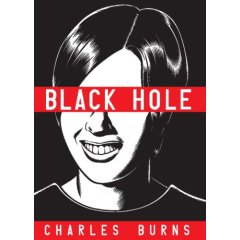Black Hole, by Charles Burns
Feb 12
2008

Charles Burns’s graphic novel Black Hole is lyrical, meticulously illustrated, and thought-provoking. It’s also creepy, stomach-churning, and unnecessarily grim. Delicate flowers might want to skip this one (as they’ll discover on page one, when they encounter a highly sexualized close-up of a partially dissected frog), but they’ll be missing out on a memorable reading experience.
Black Hole is set in mid-1970s Seattle, in a world where teenagers are coming down with a mysterious STD known simply as “the bug”. Infection results in a variety of physical transformations—characters end up with everything from webbed fingers to tadpole-shaped tentacles on their chest. Panic over the bug is widespread, but most of the characters choose to smother their fear with drugs and alcohol, rather than giving up unprotected sex with virtual strangers.
Burns’s artwork is precise and effective. I was mostly interested in his character design, but plenty of other reviewers have waxed rhapsodic about the Freudian imagery featured in the diptychs that open each chapter and the visual sexual metaphors that occur throughout the book, if that’s the kind of thing that tickles your fancy. His homely, distinctive characters—all teeth, seventies hair, and grotesque physical deformities—give weight to the novel’s emotional impact. This isn’t a story about a superhero bewailing the fact that he killed his lover with his radioactive sperm; it’s a story about a bunch of ordinary kids discovering that sex can change their lives faster than they bargained for, and frequently for the worse.
The central conceit of Black Hole is provocative, but too harsh to be plausible. Everyone makes stupid choices at some point, but they don’t always—or even usually—have the life-altering consequences that they carry in Burns’s world. The bug is obviously symbolic, but of what? Sexual initiation? If so, Burns’s vision of sex is brutal. Black Hole does show two presumably infection-free characters having sex with one another, but most of Burns’s characters have sex and promptly come down with a rampaging case of physical deformation. Why doesn’t anybody end up with a nice mutation? (Butterfly wings? Shiny pink hair?) If the bug is a manifestation of the characters’ sexual initiations, then surely someone must have had a positive experience, with positive results? But if the bug is a metaphor for sex itself... well, then I’m a little freaked out by a book that portrays sexual maturity as a face permanently covered with boils.
There are other well-written stories out there that use horror tropes to explore sexual awakening, and those of you who prefer your high-school-as-hell metaphors humorous and/or non-explicit might want to consider renting the second season of Buffy the Vampire Slayer instead. Black Hole is fascinating, but it is neither subtle nor generous with its characters. (Even Burns’s idea of a happy ending features a stolen car, abandoned families, and a pair of semi-concealable mutations.) Burns has written a coming-of-age story for anyone who really enjoyed Twin Peaks, David Cronenberg movies, or anything ever made by Jan Svankmajer—people who like their entertainment eerie, grisly, and aggressively symbolic.
Black Hole is set in mid-1970s Seattle, in a world where teenagers are coming down with a mysterious STD known simply as “the bug”. Infection results in a variety of physical transformations—characters end up with everything from webbed fingers to tadpole-shaped tentacles on their chest. Panic over the bug is widespread, but most of the characters choose to smother their fear with drugs and alcohol, rather than giving up unprotected sex with virtual strangers.
Burns’s artwork is precise and effective. I was mostly interested in his character design, but plenty of other reviewers have waxed rhapsodic about the Freudian imagery featured in the diptychs that open each chapter and the visual sexual metaphors that occur throughout the book, if that’s the kind of thing that tickles your fancy. His homely, distinctive characters—all teeth, seventies hair, and grotesque physical deformities—give weight to the novel’s emotional impact. This isn’t a story about a superhero bewailing the fact that he killed his lover with his radioactive sperm; it’s a story about a bunch of ordinary kids discovering that sex can change their lives faster than they bargained for, and frequently for the worse.
The central conceit of Black Hole is provocative, but too harsh to be plausible. Everyone makes stupid choices at some point, but they don’t always—or even usually—have the life-altering consequences that they carry in Burns’s world. The bug is obviously symbolic, but of what? Sexual initiation? If so, Burns’s vision of sex is brutal. Black Hole does show two presumably infection-free characters having sex with one another, but most of Burns’s characters have sex and promptly come down with a rampaging case of physical deformation. Why doesn’t anybody end up with a nice mutation? (Butterfly wings? Shiny pink hair?) If the bug is a manifestation of the characters’ sexual initiations, then surely someone must have had a positive experience, with positive results? But if the bug is a metaphor for sex itself... well, then I’m a little freaked out by a book that portrays sexual maturity as a face permanently covered with boils.
There are other well-written stories out there that use horror tropes to explore sexual awakening, and those of you who prefer your high-school-as-hell metaphors humorous and/or non-explicit might want to consider renting the second season of Buffy the Vampire Slayer instead. Black Hole is fascinating, but it is neither subtle nor generous with its characters. (Even Burns’s idea of a happy ending features a stolen car, abandoned families, and a pair of semi-concealable mutations.) Burns has written a coming-of-age story for anyone who really enjoyed Twin Peaks, David Cronenberg movies, or anything ever made by Jan Svankmajer—people who like their entertainment eerie, grisly, and aggressively symbolic.
Posted by: Julia, Last edit by: Julianka
No new comments are allowed on this post.
Comments
No comments yet. Be the first!